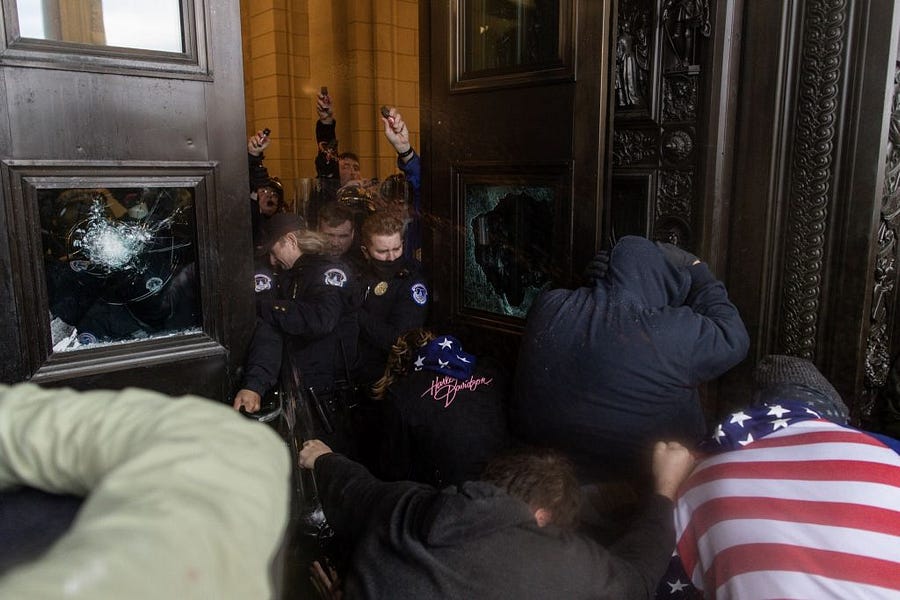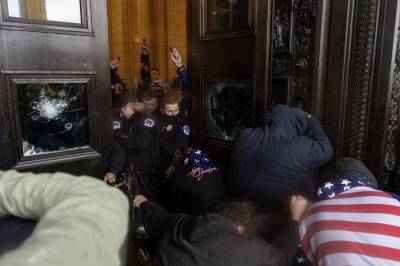Disinformation surrounding the 2021 Capitol insurrection has resurfaced in recent days following hearings of the House Select Committee to Investigate the January 6th Attack on the United States Capitol. One viral claim suggests that the Capitol’s rotunda doors had to be opened by someone “on the inside,” as strict security measures (and apparently the weight of the doors) prevented them from being opened any other way.
This claim originated with a lawyer for members of the Oath Keepers, a far-right militia whose members have been charged with various crimes associated with the attack on the Capitol. The claim received coverage from The Epoch Times, a website with a history of spreading misinformation. The attorney, Jonathon Moseley, who has since been disbarred, claimed that the doors weighed 20,000 pounds and were locked magnetically. The conspiracy theory was further spread by The Gateway Pundit, another common source for fake news, conspiracy theories, and unsubstantiated information. Gateway Pundit cites a “US Marine veteran who worked overseas at a US Embassy,” who is now a member of the Oath Keepers, and claims to have been present at the Capitol attack. The individual claimed that the doors themselves were “electronically controlled [and] magnetically locked” from the inside and outside, requiring an insider’s special code to unlock them.
The east entrance to the Capitol rotunda consists of two sets of doors, an outer set called the Columbus Doors, which are enormous ornate metal doors, and a more practical set of modern doors. The Columbus Doors, cast in bronze, are indeed 20,000 pounds, but once past these doors, a second set of doors made of wood and glass separates the outside from the Rotunda’s interior (with both sets seen clearly in photos here); it’s the breaching of the latter doors that remains in dispute, and these latter doors that are allegedly magnetic.
Interior surveillance camera footage of the Columbus Doors during the breach, released by the Department of Justice earlier this year, shows a rioter who had already entered the Capitol from a breached window on the building’s west side pushing open the interior doors with little resistance, stopping only to receive instructions from fellow rioters on the floor above him. The heavier bronze doors are already visibly open, with rioters packing the space between the two sets of doors. Video included in the Epoch Times article also shows the bronze doors open, with Capitol Police guarding the doors behind them before the rioters attacked them.
No evidence exists to support the claim that an electronic mechanism locks the doors from the inside. For one, the heavy damage sustained by the interior rotunda doors does not indicate that the doors were willingly unlocked to permit the rioters’ entry. And while the Capitol Police declined to comment to The Dispatch Fact Check on security measures at the U.S. Capitol, other sources have suggested that the doors could not have been locked from the inside because of fire evacuation and safety rules. Illinois Republican Rep. Adam Kinzinger stated as much in a February 13 Twitter post pushing back on claims of an “inside job,” and in a phone call with The Dispatch Fact Check, Laura Trivers, a communications specialist at the U.S. Capitol Visitor Center, also believed that the interior door could be easily pushed open in the event of an emergency: “If there was a fire, I would be going out that door.”
If you have a claim you would like to see us fact check, please send us an email at factcheck@thedispatch.com. If you would like to suggest a correction to this piece or any other Dispatch article, please email corrections@thedispatch.com.






Please note that we at The Dispatch hold ourselves, our work, and our commenters to a higher standard than other places on the internet. We welcome comments that foster genuine debate or discussion—including comments critical of us or our work—but responses that include ad hominem attacks on fellow Dispatch members or are intended to stoke fear and anger may be moderated.
With your membership, you only have the ability to comment on The Morning Dispatch articles. Consider upgrading to join the conversation everywhere.